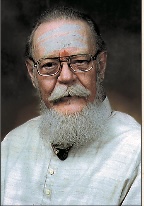By Devananda Tandavan
As I have mentioned in the past, the traditional South Indian vegetarian diet is an excellent balance of protein, fat and carbohydrates with no emphasis on undesirable fats. However, the diet I have encountered on my many Indian pilgrimages is something different. What is served by the Tamil Nadu tourist facilities and many of the other restaurants throughout the south of India, as well as in many homes, is truly a sad example of a good, healthy diet.
The food served to the public, and increasingly common in homes, is slowly killing people by creating or fostering the problems of obesity, arteriosclerosis, coronary heart disease and other degenerative diseases. This modern makeshift diet contains too much fat and sugar. There are too few vegetables, and what vegetables are served have been cooked to a mush of little nutritional value. The quality of fat used in frying is of the worst kind–the so-called tropical fats that are highly saturated–coconut, palm and palm kernel oils.
Restaurants and many private homes use and reuse these fats until they no longer remain liquid. It is common knowledge throughout the world that whenever fat is heated, the fat breaks down to harmful unknown and unnatural products. It is also common knowledge, even in India, that the use of saturated fats contributes to cardiovascular disease and other conditions.
A typical restaurant meal is fried dosai dripping with fat, vadai and deep fried potatoes or bananas. As near as could be calculated, the amount of calories from the fat far exceed the desirable “less than 30%.” Main meals consist of polished rice, rasam, sambar and a small amount of salad or vegetables. The evening meal is, again, fried foods or several kinds of rice. Even upper class homes don’t have a well-rounded vegetarian diet. When I asked why no one uses brown or unpolished rice for its added nutritional value, I was told, “That is feed for the animals.” Perhaps that is why some of the hogs and cattle seemed healthier than the people.
Desserts are almost totally sugar and eaten excessively. Children are constantly bribed with sweets to behave. Some children eat practically nothing but sweets and rice; their teeth show the disfiguring horrors of cavities and decay. Overall body stature of children in India is less than that of comparable children fed a more appropriate vegetarian diet. Is it any wonder that many residents of India are suffering from arteriosclerosis, heart disease, obesity and malnutrition?
I urge everyone to select fats that are predominantly monounsaturated–such as from olive oil, grape seed and flax oil. Don’t ever reuse fats, for even one heating causes degeneration. Reduce use of fats, as well as the amount of fried foods, and rarely deep fry. If cast iron is used to cook, a few drops of oil spread over the bottom of the pan is sufficient even for frying dosai. I also urge use of raw vegetables and slightly cooked vegetables, with as much variety as possible. One should consume some dark green leafy vegetables every day. The flavor of the unpolished rice is very good, and its nutritional value is much greater. There are also other grains that can be used as rice substitutes. Elders and children will benefit greatly by the reduction of the amount of sugar and sugary products.
Dr. Tandavan, 78, retired nuclear physician and hospital staff president, lives in Chicago, where he specializes in alternative healing arts. If you are interested in further articles on health and healing visit his home page. [http://www.himalayanacademy.com/books/drt/]
